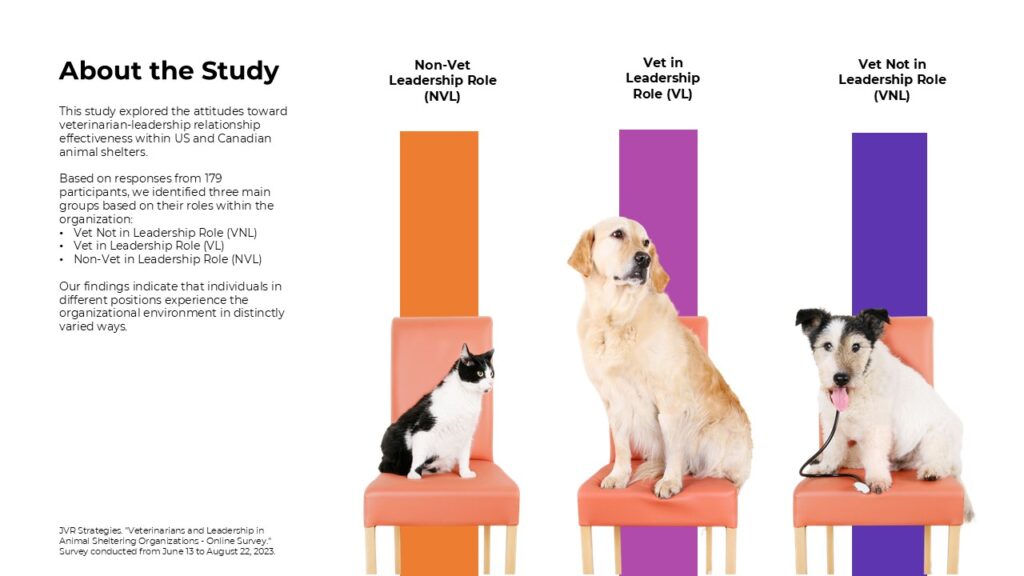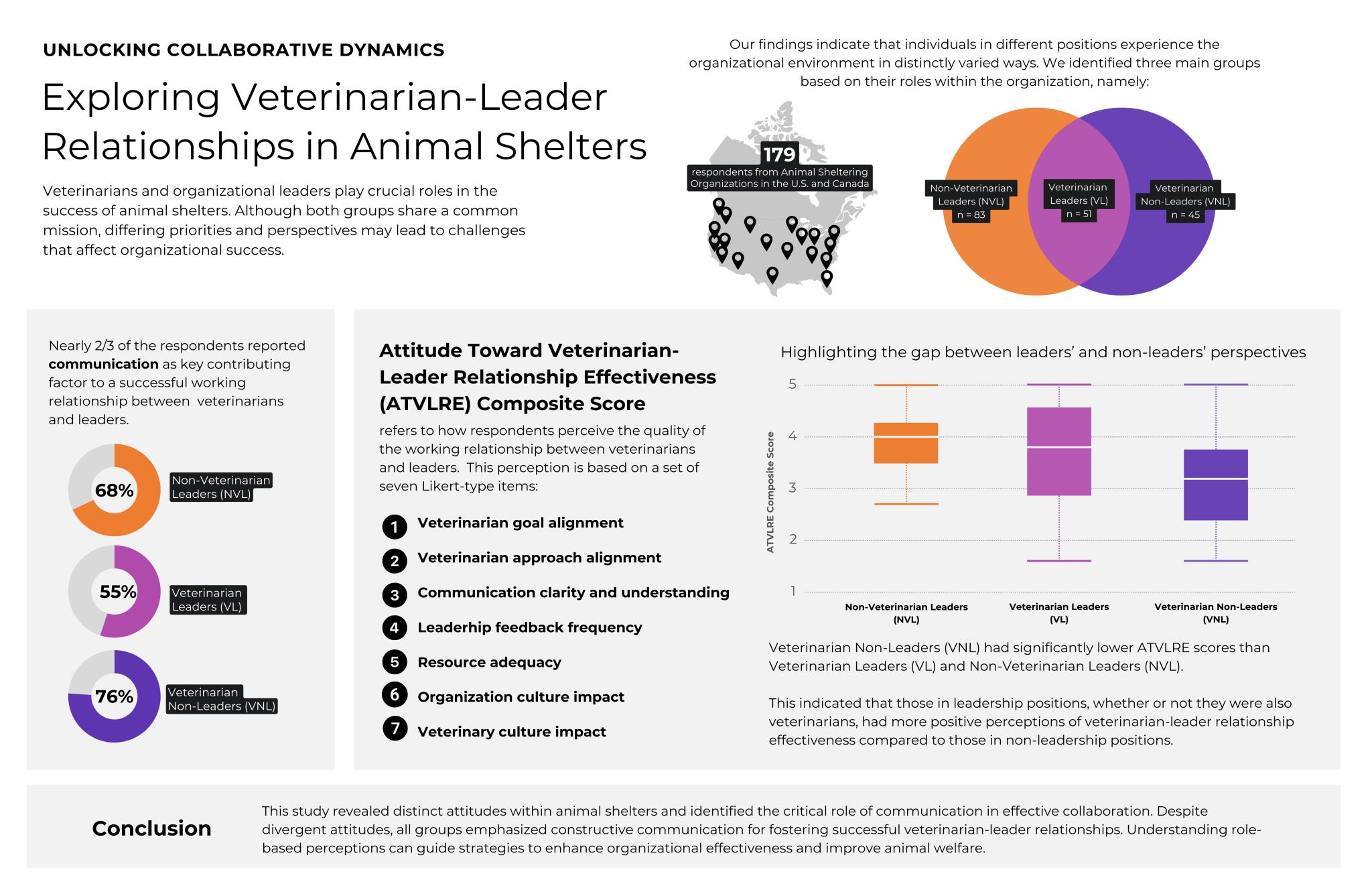Unlocking Collaborative Dynamics: Exploring Veterinarian-Leadership Relationships in Animal Shelters
Veterinarians and organizational leaders are at the heart of every animal shelter’s success. While they share a common mission—to improve animal welfare—their distinct roles often bring different priorities, perspectives, and challenges. A new study published in the Journal of Shelter Medicine and Community Animal Health sheds light on the dynamics between veterinarian-leadership relationships, revealing critical insights that can reshape collaboration within the field.
Conducted by JVR Strategies, this study examines the attitudes of veterinarians and leaders toward collaboration and identifies the key factors that influence these relationships. The findings underscore the importance of effective communication as the foundation for strong veterinarian-leadership partnerships.
Study Overview: Understanding the Veterinarian-Leader Dynamic
The research surveyed 179 veterinarians and animal shelter leaders between June and August 2023, gathering insights into their attitudes toward collaboration. Participants were categorized into three groups:
- Non-veterinarian leaders – leaders who are not veterinarians
- Veterinarian leaders – veterinarians in leadership positions
- Veterinarian non-leaders – veterinarian who are not in leadership positions
The study used a composite score to measure attitudes toward veterinarian-leader relationship effectiveness (ATVLRE) and analyzed statistical differences between the groups. The results highlight key variations in how each group perceives collaboration.

Dissecting the Key Findings
Variations in Attitudes Across Roles
One of the primary insights from the study is the distinct variation in attitudes toward internal relationships:
- Non-veterinarian leaders recorded the highest positive ATVLRE with a mean score of 4.0 (SD = 0.6).
- Veterinarian leaders followed with a mean score of 3.7 (SD = 1.0).
- Veterinarian non-leaders reported the lowest positive ATVLRE, with a mean score of 3.1 (SD = 0.9).
These findings indicate a clear disparity: while non-veterinarian leaders maintain an optimistic outlook regarding collaborative dynamics, veterinarians—particularly those not in leadership roles—are more critical of the current state of communication and role alignment.
Communication as the Cornerstone
Across all groups, communication surfaced as the linchpin of successful veterinarian-leadership relationships:
- A significant 70% of veterinarian non-leaders highlighted “lack of effective communication” as their primary challenge.
- Veterinarian leaders pointed to communication difficulties in 54% of responses.
- In comparison, only 27% of non-veterinarian leaders identified communication issues as a major concern.
This data underscores a pressing need to focus on how information flows within shelters, with a clear indication that improving dialogue could mitigate many of the identified challenges.
Diverging Challenges: Priorities and Expectations
Beyond communication, the study revealed additional hurdles:
- Veterinarian leaders were most affected by differences in priorities or conflicting goals, with 66% citing this challenge.
- Non-veterinarian leaders reported that managing expectations and demands was a recurring concern (55%).
These statistics reflect the inherent differences in professional focus between those providing clinical care and those managing operational aspects. Such disparities are not just numbers—they highlight everyday challenges that can impact shelter performance and, ultimately, animal care.

Reflecting on the Study’s Scope and Context
It is important to view these findings within the context of the study’s design. Data were collected during a defined period in 2023, reflecting the conditions and challenges specific to that timeframe. As with any survey-based research, the results capture a snapshot of attitudes that may evolve. Nonetheless, the mixed-method approach—combining numerical data with firsthand accounts—provides a robust foundation for understanding the internal dynamics of animal shelters.
The emphasis on clear communication, as consistently identified by participants, suggests that even in a well-meaning organization, misalignments can occur when the channels of dialogue are not robust. The study reminds us that the strength of any team lies in its ability to communicate effectively and align on common goals.
What This Means for Animal Shelters
This research highlighted the significance of role-based differences in perceptions and emphasized the critical importance of communication across all roles. This can provide a foundation for developing strategies to improve internal dynamics, support veterinarians, and enhance animal welfare practices, ultimately benefiting animals, professionals, and the communities they serve.
This study provides a crucial look into the veterinarian-leadership dynamic, revealing the need for greater understanding and intentional communication strategies. By focusing on empirically grounded data, it reveals a clear picture: non-veterinarian leaders tend to view internal relationships more favorably, while veterinarian non-leaders report significant challenges—primarily around communication and differing priorities. While challenges exist, the shared goal of improving animal welfare remains a unifying force. By recognizing and addressing communication barriers, animal shelters can create stronger, more effective teams that ultimately lead to better outcomes for animals and communities alike.
At JVR Strategies, our mission is to provide clarity through data and to drive operational excellence in animal welfare. The insights derived from this study are a valuable resource for shelter professionals seeking to understand and address the challenges within their organizations. By laying bare the realities of internal dynamics, we empower shelters to make informed decisions that ultimately enhance the quality of care provided to animals.
As the animal sheltering landscape continues to evolve, embracing a data-driven approach to internal relationships will remain a cornerstone of operational success. We remain committed to advancing this conversation, ensuring that every animal shelter is equipped with the knowledge and tools necessary to thrive.
You can access the full paper below.
About the Authors
This study was conducted by the JVR Strategies team, dedicated to advancing leadership and operational excellence in animal welfare. The research team includes:
- Clinton Ross Mauck (ORCID)
- Marjorie Robin Vincent (ORCID)
- Jyothi Vinnakota Robertson, DVM, DABVP (ORCID)
For full details, read the study published in the Journal of Shelter Medicine and Community Animal Health.
Reference
Mauck, C. R., Vincent, M. R., & Robertson, J. V. (2024). Unlocking collaborative dynamics: Exploring veterinarian-leadership relationships in animal shelters. Journal of Shelter Medicine and Community Animal Health, 4(1), 108. https://doi.org/10.56771/jsmcah.v4.108
